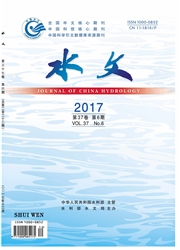

 中文摘要:
中文摘要:
基于传统时变增益模型(TVGM),进一步考虑地下径流退水,在传统TVGM只考虑单一地表水源的基础上,添加地下水源模块,对地表地下径流分别进行产、汇流计算,改进并提出了多水源TVGM,并将其应用于淮河流域蚌埠闸以上13个水文站控制的代表性子流域。结果表明:多水源TVGM既继承了传统TVGM以简单结构描述复杂水文非线性系统关系的优点,同时通过增加地下水源模块,大大提高了洪水预报的精度。13个子流域参数率定期和模型验证期中,传统TVGM分别有9个和7个子流域达到乙级洪水预报标准,而多水源TVGM分别提高到12个和8个,其中以大型流域和大水年改进效果尤佳。传统TVGM水量平衡系数为0.88,多水源TVGM提高到0.95,平均提高了7%。洪峰模拟相对误差也由传统TVGM的50%达标率提高到多水源TVGM的92.3%,整体提高了42.3%。因此,多水源TVGM能更好的应用于淮河流域洪水预报工作。
 英文摘要:
英文摘要:
Based on traditional Time Variant Gain Model (TVGM), this paper developed a multi-source TVGM (MTVGM) by con- sidering the additional baseflow process. MTVGM is composed of surface flow submodel and baseflow submodel, which independently calculate the runoff generation and flow concentration respectively. The model was then applied to 13 subbasins above Bengbu water sluice in the Huaihe River Basin. The results show that MTVGM can not only keep the advantage of the TVGM which uses the simple structure to describe the complexity in nonlinear hydrological relationship, but also greatly improve the forecast accuracy. Among the parameter calibration and model verification period, the forecast accuracy of 9 and 7 subbasins respectively meet the B-grade for traditional TVGM, while the subbasin numbers increase to 12 and 8 respectively for MTVGM. The performance of MTVGM was especially improved in large basins and large flood years. The water balance efficiency improves from 0.88 of TVGM to 0.95 of MTVGM, and the average increase is about 7%. The relative flood peak error is also promoted from 50% in TVGM to 92.3% in MTVGM, with an improvement of 42.3% in total. Therefore, MTVGM can be better applied in flood forecasting in Huaihe River Basin.
 同期刊论文项目
同期刊论文项目
 同项目期刊论文
同项目期刊论文
 期刊信息
期刊信息
